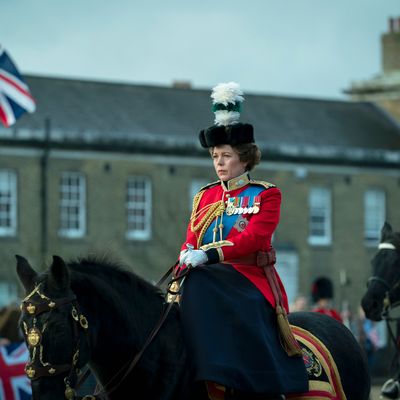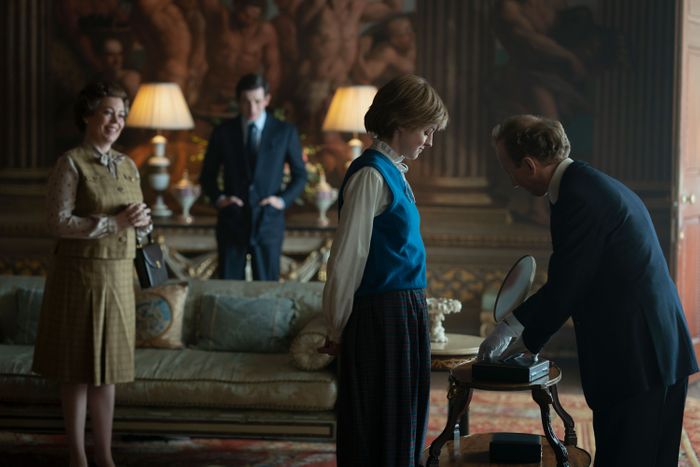
Episode two of The Crown’s fourth season is called “The Balmoral Test,” and it lays out the two through lines of the season in a precisely balanced, extremely satisfying way. Elizabeth and Philip, played once again by Olivia Colman and Tobias Menzies, are at the family vacation home way out on the Scottish highlands with the rest of the royal family. There are guests on this vacation trip. First, there’s the newly elected prime minister Margaret Thatcher (Gillian Anderson) and her husband, Denis (Stephen Boxer). After the Thatchers leave, Diana Spencer (Emma Corrin) arrives, ready to be inspected as a potential wife for Charles (Josh O’Connor).
They’re all being subjected to the infamous “Balmoral test,” a term for what happens when new people receive an invitation to the family’s private home, and the episode is divided in two. First we watch as the Thatchers, anxious to please and utterly out of their element, fail shibboleth after shibboleth. They know they’re failing, and they still try to soldier on, meanwhile the royals are absolutely unrelenting in their icy, superficial politeness and subterranean mockery. Then the Thatchers leave and Diana arrives, meek and unassuming and exhibiting just enough backbone that things go quite differently for her.
It’s my favorite kind of episode of The Crown, and a perfect example of what the show does best. It is self-contained and finely wrought, a delicious hour in which each note strikes with the reliable, measured precision of a clock that keeps excellent time. It’s funny, sometimes wickedly so, with the sort of gossipy eye for detail that you want to slurp up greedily and then crow about as soon as it’s done. The shoes! The corgis! The party-game scene! It’s not always the most subtle — there’s little ambiguity in how the parallel tests plays out, and The Crown leans more toward big, obvious symbolism here than it does delicate nuance. But it’s gloriously entertaining and so absolutely, impeccably well made and well acted. I wouldn’t trade its conspicuous deer-stalking metaphor for anything.
The two tracks established in “The Balmoral Test” are the defining trajectories for the season. On one side, there’s Margaret Thatcher, played by Anderson with total relish and uncanny accuracy. Her wig alone is a marvel of the modern world. But Thatcher shines most brightly in every scene she shares with Colman’s Elizabeth, where they puzzle about one another and poke at their mutual prejudices and blind spots. On the other side, there’s the ascendant Diana, rushed into the scaffolding of a fairy-tale marriage that could never exist and gradually becoming an image of modern royal femininity that garners global applause even while she privately rages and suffers.
Anderson’s Thatcher is remarkable and alarming; The Crown’s hair and makeup team swears that Anderson didn’t use any prosthetics, and although I fully believe Anderson is capable of it, knowing that she held Thatcher’s strained grimace without the aid of a mouthpiece adds an undercurrent of pain to the performance that makes a lot of sense. Anderson’s Thatcher captures an anxiety in the woman, the self-recriminating fervor of the zealot who believes in her cause absolutely but whose belief relies on the sense that goodness comes out of pain, out of restriction, austerity, and grim self-control. The way Anderson holds her mouth, you get the impression that especially as the decade goes on, Thatcher’s trying to tamp down on the country’s excesses through the force of her cheek muscles alone. It’s ghoulish, but also it hurts.
Corrin, meanwhile, has to take on a nearly impossible task. Thatcher is a familiar face, a well-known specter of an era who looms large in the press and in living memory. But Diana? Diana is a global superstar, and attempting to take on not just the famous fashion but the famously unusual charisma of someone so thoroughly stamped on the cultural imagination — it’s a tall order. What Corrin accomplishes is pretty miraculous. She is young, and the dominant impression of Diana’s incredible tenderness makes the character into a wobbling pool of vulnerability inside a transparent self-protective shell. She grows into her power, but Corrin’s able to keep that core of tenderness even as Diana gets more comfortable with being in public and more confident in her press persona. It’s not a condescending portrayal, and it doesn’t turn Diana into a victim or a perpetrator. She’s just a mess, and she has joined a mess of a family, and The Crown has utmost sympathy while also, unerringly, zooming in on the messiest, most painful parts.
Together, Thatcher and Diana give The Crown an energy and a sense of direction it lacked in the third season, and a feeling of verve the show has arguably never approached before. In the writing and in the performances, there is this sense that everyone involved has finally gotten to the good stuff, and they’re all pleased as punch about it. The treatment of Charles and Diana’s marriage is as complex and nuanced as that big deer-stalking metaphor in the Balmoral episode is not, and for as good as Corrin is as Diana, O’Connor embodies an entitled, thoughtless, jealous, and wounded Charles all the way out to the tips of his ears. Emerald Fennell as Camilla Shand is just as good; there’s an especially masterful scene in which she has Diana for lunch (literally lunching at a restaurant and absolutely demolishing Diana’s self-esteem).
Best of all, though, season four of The Crown manages to illuminate Queen Elizabeth as a person in a way the previous three seasons of marriage-based storytelling have never managed. It has always been the greatest challenge at the center of the show, something The Crown has never really navigated effectively. Elizabeth spurns all attempts at insight and psychoanalysis; her façade impenetrable, but also the person and the façade seem to have merged almost entirely. Sometimes it feels like trying to get inside the private life of a ceremonial hat — or at least that’s about as successful as The Crown has been, through no fault of Colman or Claire Foy. She’s a character whose internal life is only accessible when she’s seen with a foil, someone who can put the Queen’s desires and interests on display by contrasting or complementing them. To date, The Crown has tried this primarily with Philip and with Margaret (played once again this season by Helena Bonham Carter) and a bit with some of the prime ministers. It’s hard to get past the headlines, though. She loves horses and dogs and tromping around in Wellies and the absolute annihilation of visible human weakness on the public stage. She understands the need for ceremony. She hates a fuss.
It does not feel like a coincidence that the first season of The Crown to cast Elizabeth in between two potent female characters is also the first season of The Crown during which Elizabeth becomes really interesting. In fading into the background a little, she paradoxically becomes more distinct. Qualities like her iron backbone, her clueless sheltered world, and her desire to be good are all things that suddenly seem more human. This is also the first real glimpse of the modern Elizabeth, notably and hopelessly defined by how unmodern she is. The triumvirate of them — Thatcher’s vision for the future, Diana’s half-purposeful embodiment of the future, and the Queen’s frustration with both of them — makes it not just a good handful of episodes of The Crown but the best complete season the show has ever made.



